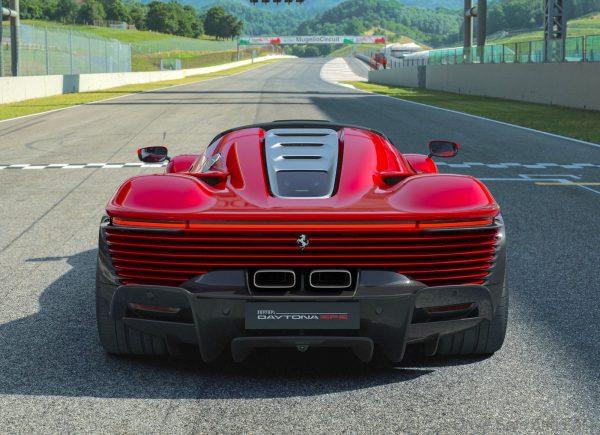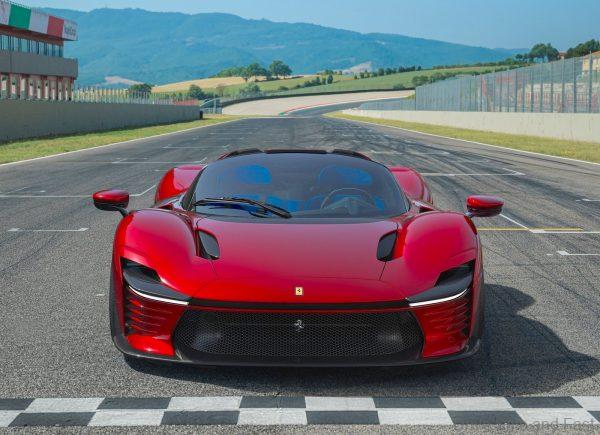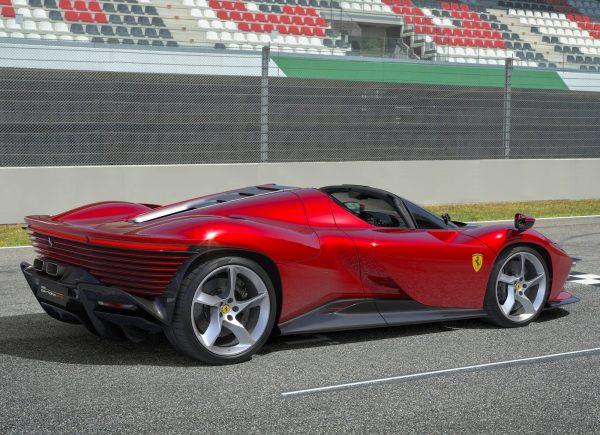The Ferrari Daytona SP3 has been revealed as part of the company’s Icona series.
Ferrari have just revealed the limited edition Daytona SP3. This joins the Monza SP1 and Monza SP2 in the Icona series. The Ferrari Daytona SP3 takes inspiration from the company’s 1967 24 Hours of Daytona win at the International World Sports Car Championship. 2 Ferrari 330s and a 412 dominated the podium for a legendary 1-2-3 finish.

This model takes its design cues from retro Ferraris such as the 330 P4, 350 Can-Am and 512 S and features a targa body with a removable hard top. Ferrari says three fundamental areas define the Daytona SP3’s performance:

Ferrari’s most powerful engine – The naturally-aspirated 6.5L V12 engine in here is borrowed from the 812 Competizione, but reworked to produce 828 horsepower and 697Nm of torque. This immense amount of power was extracted by reworking the motor and using titanium connecting rods, new piston pins with a Diamond-Like Carbon treatment. The intake system have been redesigned as well with a more compact manifold and plenum, a continuously variable intake tract assembly, and more. 2 petrol pumps and 4 rails with pressure sensors work with new management strategies for the gasoline direct injection system to deliver fuel at 350 bar of pressure.
The F140HC engine has a 9500rpm redline and sends power to the wheels via a 7-speed gearbox. This enables the Ferrari Daytona SP3 to accelerate from 0-100km/h in just 2.85 seconds and from 0-200km/h in just 7.4 seconds.
A chassis built entirely of composite materials – Ferrrari’s Formula 1 technologies trickle down into supercars very rarely. The last time this happened was with the LaFerrari. Now the Daytona SP3 gets the F1 treatment by doing things like integrating the driver’s seat into the chassis and reducing the car’s overall weight and improving the driver position. Aeronautical grade composites were used, including T800 carbon fibre on the tub and T1000 carbon fibre on the doors and sills. Kevlar was deployed on the areas most susceptible to impact. Autoclave curing techniques used on Formula 1 cars were used on this Daytona Sp3.

Maximum aerodynamic efficiency without the use of active aero – Despite using only passive aero solutions, Ferrari pushed the envelope with the Daytona SP3 and produced their most aerodynamically efficient car ever. Ferrari engineers created floor chimneys that connected the two integrated louvres in the rear wings by vertical ducts. This creates a natural suction for a fluid-dynamic connection between the flows over the upper bodywork and the underbody. This reduces blockages of the underbody, increases local acceleration of the flow created by the geometry of the intakes and it feeds additional airflow to the rear spoiler.

Ferrari Daytona SP3 Design
The car’s design has been universally praised for its overall balance, surfacing and its respectful use retro design elements. The Daytona SP3 features butterfly doors with integrated air boxes to channel air to the side-mounted radiators. It also has mirrors mounted to the front wheel arches and rear flanks that swell out and then taper towards the tail end.
Horizontal blades complete the retro look of the rear, a nod to Ferrari’s older designs, like on the Testerossa. The front of the Ferrari Daytona SP3 features two wings with inner and outer crests. The front bumper features a large central grille framed by 2 pillars and a series of stacked horizontal blades.

Inside, we find even more inspiration from older Ferraris like the 330 P3/4, 312 P and 350 Can-Am. The Ferrari Daytona SP3’s structure means that the trim extends all the way to the quarterlights, hugging the entire area connecting with the windscreen. The slender, taut dashboard seems almost to float within the upholstery. Its styling theme develops on two levels: the upper trimmed shell, which has a clean, sculptural look, is separated from the lower one with a clear textural and functional dividing line. All of the Human-Machine Interface (HMI) touch controls are clustered below this line

The seats are integrated into the chassis and thus have the ergonomic wraparound design typical of high-performance cars, but also the kind of meticulous detailing that sets them apart. The textural connection between the seats and the extension of the theme to the adjacent trimmed areas, as well as certain volumetric effects, were possible because they are fixed, while the driver’s adjustments are taken care of by an adjustable pedal box. The clear break between the technical area of the cockpit and the occupant area also allowed the seat volume to be extended all the way to the floor. Even the headrests reference their competition counterparts, but while in the latter they are integrated into single-piece seats, in the Daytona SP3 they are independent. The fixed seat and adjustable pedal box architecture meant they could be anchored to the rear trim, thus also helping to visually lighten the cockpit.

TECHNICAL SPECIFICATIONS
- POWERTRAIN
- Type: V12 – 65°
- Total displacement: 6496 cc
- Bore and stroke: 94 mm x 78 mm
- Max. power output: 618 kW (840 cv) @ 9250 rpm
- Max. torque: 697 Nm @ 7250 rpm
- Max. revs: 9500 rpm
- Compression ratio: 13.6:1
- DIMENSIONS AND WEIGHT
- Length: 4686 mm
- Width: 2050 mm
- Height: 1142 mm
- Wheelbase: 2651 mm
- Front track: 1692 mm
- Rear track: 1631 mm
- Dry weight: 1485 kg
- Dry weight/power ratio: 1.77 kg/cv
- Weight distribution: 44% front / 56% rear
- Fuel tank: 86 litres
- TYRES AND WHEELS
- Front: 265/30 ZR 20 J9.0
- Rear: 345/30 ZR 21 J12.5
- BRAKES
- Front: 398 x 223 x 36 mm
- Rear: 380 x 253 x 34 mm
- TRANSMISSION AND GEARBOX
- F1 dual-clutch gearbox, seven speed
- ELECTRONIC VEHICLE CONTROLS
- ESC; high performance ABS e/EBD; F1-Trac; e-Diff 3.0; SCM-Frs; SSC (Side Slip Control) 6.1
- PERFORMANCE
- Top speed: >340 km/h
- 0-100 km/h: 2.85 s
- 0-200 km/h: 7.4 s